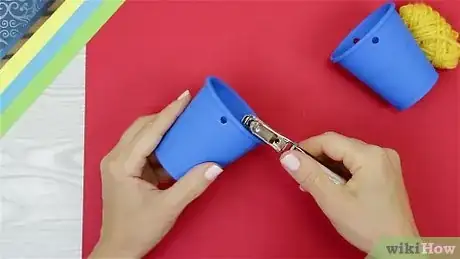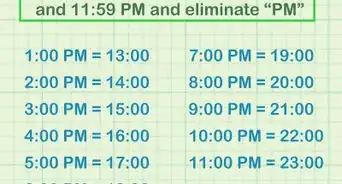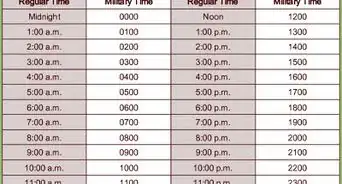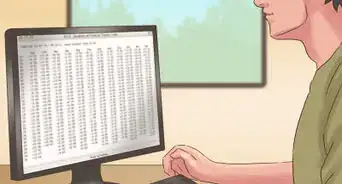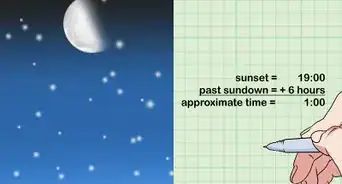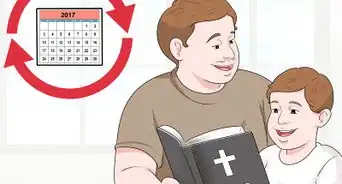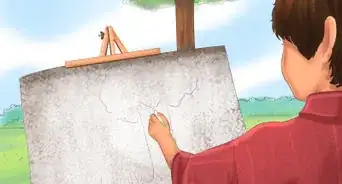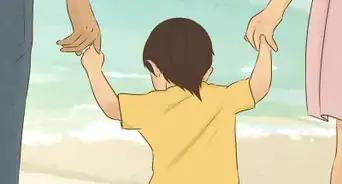This article was co-authored by wikiHow staff writer, Kyle Hall. Kyle Hall works on the content team at wikiHow. He helps manage our team of editors and creates content for a variety of wikiHow projects. Kyle continually looks for new ways to improve the content at wikiHow and make it more helpful and enjoyable for readers. He graduated from Eckerd College in 2015, where he majored in Political Science.
The wikiHow Video Team also followed the article's instructions and verified that they work.
This article has been viewed 277,608 times.
Learn more...
Learning to balance counterweights is a useful skill for young kids, and a balance scale is a great way to teach them. By making a balance scale, you can start a solid foundation in physics in a single afternoon. All you need to get started are some simple household items.
Steps
Making Buckets for the Scale
-
1Use a hole punch to make holes in 2 small paper cups. Punch 2 holes in each cup. Make the holes close to the rim of the cups and on opposite sides.[1]
- If you don’t have paper cups, you can make the buckets for your balance scale with plastic cups instead.
-
2Cut 2 pieces of twine that are each around 1 foot (0.30 m) long. Any kind of twine will work, but a thick, strong twine will make the balance scale more durable. After you cut the twine pieces, lay them next to each other to make sure they’re the same length. If they're not, cut them with scissors to adjust their lengths.[2]Advertisement
-
3Tie the ends of the twine through the holes in the cups. Use 1 piece of twine per cup. When you’re finished, the twine pieces should form thin handles on the cups, like the cups are little buckets.[3]
Putting the Scale Together
-
1Find a notched clothes hanger. A plastic, metal, or wooden hanger will work, as long as it has a notch on both sides of the hook. Otherwise, the paper buckets will slip and fall right off the scale.[4]
- If you don’t have a notched clothes hanger, you can use some more twine to tie the handles on the paper buckets to the bottom of a regular clothes hanger so they don’t fall off.
-
2Hang the buckets on the clothes hanger using the twine handles. Hang the cups on opposite sides of the clothes hangers in the notches. When you're finished, lift up the scale and hold it by the top to examine the buckets. Both buckets should be hanging at the same level — if one is higher than the other, you'll need to adjust the twine handles.[5]
-
3Let your kids decorate the buckets on their new balance scale. Put out stickers, markers, and crayons and let your kids personalize the scale. They'll enjoy playing and learning with it more if they get to add their own personal touch.
- One way to decorate the scale is to help your kids write their names on it.
- Don't attach anything too heavy to the buckets or it could interfere with how the scale works.
Using the New Scale
-
1Hang your balance scale on a doorknob. Doorknobs are great to hang balance scales from because they’re low enough for kids to reach them. If you can’t find a doorknob to use, look for any kind of handle or bar you can hook the clothes hanger onto.[6]
-
2Help your kids look for objects to put on the scale. Any kind of object will work, as long as it’s small enough to fit in the paper buckets you made. Some fun objects you could try weighing are:
- Your kids’ favorite small toys.
- Different rocks that your kids find outside.
- Small fruits like strawberries, blueberries, and grapes.
-
3Have the kids experiment putting the different objects in the cups. When the object in 1 cup weighs more than the object in the other cup, the heavier cup will sink and tip the scale. Explain to your kids that the lower bucket has the heavier object, and the higher bucket has the lighter object.[7]
Community Q&A
-
QuestionHang it on a doorknob? How does that work, since yogurt cups are generally wider than the distance the middle part of a doorknob sticks out from a door?
 HumanBeingTop AnswererA door knob is perhaps not the best place to hang this improvised balance scale. Before making your scales, you may like to find a suitable location to hang the coat hanger. If you can't find a level rail or bar or other appropriate place that your child can easily reach, this might not be a good project. Purchasing toy balance scales from a retailer of educational toys and games might be a better idea.
HumanBeingTop AnswererA door knob is perhaps not the best place to hang this improvised balance scale. Before making your scales, you may like to find a suitable location to hang the coat hanger. If you can't find a level rail or bar or other appropriate place that your child can easily reach, this might not be a good project. Purchasing toy balance scales from a retailer of educational toys and games might be a better idea. -
QuestionHow do I know which side is heavier?
 Community AnswerWhichever side is lower than the other is heavier.
Community AnswerWhichever side is lower than the other is heavier. -
QuestionWill this work if I don't do it with my child?
 Community AnswerYes, but it's more fun to make this into a game to play with children.
Community AnswerYes, but it's more fun to make this into a game to play with children.
Things You’ll Need
- Notched clothes hanger
- Hole punch
- 2 paper cups
- Twine
- Scissors
References
- ↑ https://gosciencekids.com/diy-balance-scales-toddlers-preschoolers/
- ↑ https://www.youtube.com/watch?v=ZX4WWOtgDfs&feature=youtu.be&t=91
- ↑ https://www.youtube.com/watch?v=ZX4WWOtgDfs&feature=youtu.be&t=91
- ↑ https://web.kidsactivitiesblog.com/17228/science-for-kids-hanger-balance
- ↑ https://web.kidsactivitiesblog.com/17228/science-for-kids-hanger-balance
- ↑ https://gosciencegirls.com/diy-balance-scales-toddlers-preschoolers/
- ↑ https://gosciencegirls.com/diy-balance-scales-toddlers-preschoolers/
About This Article
To make a balance scale for kids, start with 2 paper cups and punch 2 holes on opposite sides of each cup, close to the rim, to make buckets. Then cut 2 pieces of twine to about 1 foot each, making sure they’re exactly the same length. Next, pair each piece of twine with a cup and tie the ends of the twine through the holes to make handles. You can then put the scale together just by hanging the buckets off the ends of a notched clothes hanger. To learn how to use your new balance scale, scroll down!
